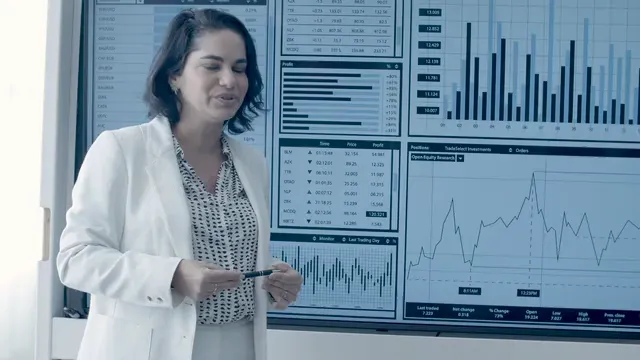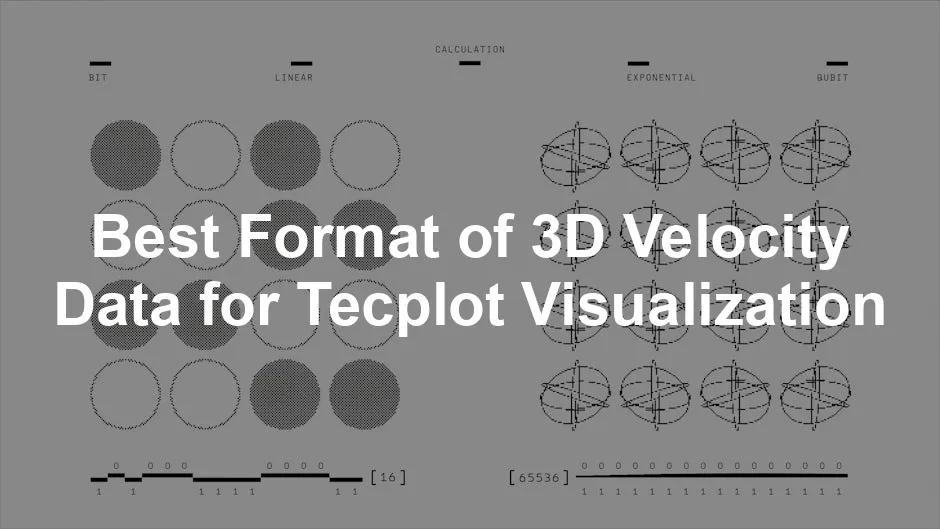Introduction
Choosing the right data format is vital for 3D velocity visualization. Proper formatting ensures accurate representation of data within Tecplot. This article aims to highlight the best formats for 3D velocity data, helping you make informed decisions.
Summary and Overview
Tecplot is a leading visualization tool for scientific and engineering data. It transforms raw data into visually engaging outputs, making analysis easier. However, the effectiveness of visualization hinges on how well the data is formatted. Properly formatted data leads to clearer visuals and faster processing.
This article discusses various formats, including ASCII, binary, Tecplot native, VTK, HDF5, and CSV. Each format has unique strengths and weaknesses. The choice of format influences performance, visualization capabilities, and overall user experience. Picking the right one can enhance your workflow significantly.
For beginners looking to dive deeper into data visualization, I recommend checking out Data Visualization: A Practical Introduction. This book makes the complex world of data visualization approachable and fun!
Understanding 3D Velocity Data Formats
Importance of Data Format
Selecting the right data format is crucial for visualization quality in Tecplot. A well-chosen format enhances how accurately your 3D velocity data displays. Poorly formatted data can lead to distorted visuals or missing information.
Data integrity is another key factor. Formats that support robust structures help maintain the accuracy of your data. Performance also plays a role; some formats load quickly while others may lag, impacting your workflow. Striking a balance between quality and performance ensures smooth data visualization, allowing you to focus on analysis rather than preparation.
If you’re looking to understand the technical aspects of data formats, grab a copy of HDF5: The Definitive Guide. It’s a must-read for anyone dealing with large datasets!
Common Formats for 3D Velocity Data
1. Tecplot ASCII Format (.dat)
Tecplot ASCII format, often seen with the .dat extension, is widely used for direct plotting in Tecplot. This format is human-readable, making it easy to create and edit. It’s particularly useful for small to medium datasets, offering flexibility for customization.
However, there are drawbacks. The file sizes can become quite large, especially with extensive datasets. This may lead to slower loading times, which can hinder productivity when analyzing data. Despite its limitations, many users prefer ASCII for its simplicity and ease of manipulation.
If you’re interested in data science, you might also want to check out Data Science for Business: What You Need to Know about Data Mining and Data-Analytic Thinking. This book will give you a solid foundation in the principles of data science!
2. Tecplot Binary Format (.plt)
The Tecplot binary format, identified by the .plt extension, is another popular choice. It provides a more compact data structure compared to ASCII. This leads to significantly smaller file sizes and improved loading times, making it ideal for large datasets.
On the downside, the binary format is not human-readable, making manual editing challenging. Additionally, accessing this format requires Tecplot, limiting flexibility when sharing data with others. Despite these disadvantages, its efficiency often makes it the preferred option for heavy data users.
For those wanting to dive deeper into visualization techniques, consider picking up Data Visualization: Charts, Maps, and Interactive Graphics. This book is perfect for learning how to present your data visually.
3. VTK (Visualization Toolkit) Format (.vtu, .vtk)
VTK is a popular format designed for scientific visualization. It’s versatile and supports various data types and structures, making it ideal for complex geometries. You can find it in many applications, ranging from fluid dynamics to bioinformatics.
One major advantage of VTK is its compatibility with many visualization tools. This means your data can be easily shared across different platforms. Additionally, it handles intricate geometries and unstructured grids well, providing rich metadata support.
However, creating and editing VTK files can be complex. You may need specific software or libraries to manipulate these files effectively. This complexity can be a barrier for users who prefer simpler formats. Despite this, the benefits often outweigh the drawbacks for advanced visualization needs.
If you’re interested in learning more about scientific computing, check out An Introduction to Scientific Computing: Twelve Numerical Methods Using Python. It’s a fantastic resource for understanding numerical methods!
4. HDF5 (Hierarchical Data Format 5)
HDF5 is a high-performance format tailored for managing large datasets. It shines in fields such as engineering and scientific research, where data volume can be overwhelming. This format supports complex data structures and is efficient for both storage and retrieval.
One standout feature of HDF5 is its ability to compress data. This can save significant storage space, which is crucial for large datasets. Additionally, its flexible data model allows for easy organization and access to data, enhancing usability.
On the downside, HDF5 can be challenging to work with. Users often require additional libraries or tools to handle this format effectively. This complexity may deter those unfamiliar with its structure. Still, for those who need to manage large volumes of data, HDF5 remains a top choice.
If you want to get a solid understanding of data analysis, I suggest picking up Python for Data Analysis: Data Wrangling with Pandas, NumPy, and IPython. It’s an essential guide for anyone getting started in data analysis!
5. CSV (Comma-Separated Values)
CSV is a straightforward text-based format widely used for data storage. Its simplicity makes it accessible for users at any skill level. You can easily create and edit CSV files using standard text editors or spreadsheet software.
One of the main advantages of CSV is its ease of use. You can manipulate data quickly, making it ideal for smaller datasets. This accessibility encourages collaboration, as many tools support CSV format.
However, CSV has limitations. It struggles with large datasets, leading to performance issues. Additionally, it offers limited support for metadata, which can hinder more complex analyses. For basic visualization tasks, though, CSV remains a popular choice.
Choosing the Best Format for Your Data
When selecting a format for 3D velocity data, several key factors come into play. Understanding these will help you make the best choice for your visualization needs.
First, consider the dataset size. Large datasets often require formats that handle efficient storage and quick loading times. Formats like binary (.plt) or HDF5 are excellent for this. They reduce file size and enhance performance. Smaller datasets, however, can work well even with ASCII formats.
Next, think about data structure and compatibility. Your chosen format should easily integrate with other tools or software you may be using. For instance, VTK supports complex geometries and is widely compatible across various platforms. If you’re using specialized CFD software, its native format may be the most efficient choice.
Visualization requirements are also crucial. Some formats offer richer metadata or support for advanced visualizations, like VTK or HDF5. These formats can better accommodate intricate visual techniques, enhancing the clarity of your data representation.
Finally, user familiarity with formats plays a significant role. If you’re new to data visualization, starting with more straightforward formats like CSV or ASCII can help you grasp the concepts without overwhelming complexity. Once you’re comfortable, you can transition to more advanced formats as needed.
By weighing these factors, you can confidently choose the best format for your 3D velocity data, optimizing your experience with Tecplot.
Best Practices for Working with 3D Velocity Data in Tecplot
Data Preparation
Preparing your 3D velocity data for Tecplot is essential for effective visualization. Start with data cleaning and validation. Identify and rectify any inconsistencies or errors within your dataset. This step ensures that your visualizations accurately reflect the underlying data.
Efficient data management is another vital practice. Organize your data logically, making it easy to access and manipulate as needed. Consider using consistent naming conventions and folder structures. This organization will streamline your workflow and reduce frustration when navigating through your datasets.
Additionally, always keep backups of your original data before making any changes. This practice protects your work and allows you to revert to previous versions if necessary. By following these best practices, you will ensure a smoother experience when visualizing your 3D velocity data in Tecplot.
And if you’re looking for a fantastic resource on data visualization techniques, you should definitely check out The Big Book of Dashboards. It’s packed with practical examples!
Visualization Techniques
When it comes to visualizing 3D velocity data in Tecplot, several methods stand out. Contour plots are highly effective for representing scalar fields, such as velocity magnitude. They provide a clear view of how velocity varies across a space. Streamlines are another excellent choice, illustrating the flow direction and patterns in your dataset. These visualizations can reveal important insights into the behavior of fluids.
To maximize the effectiveness of your visualizations, consider the following recommendations. First, choose color schemes that enhance clarity and contrast. Avoid overly complex palettes that may confuse the viewer. Next, adjust the resolution of your plots to ensure details are captured without overwhelming the viewer. Finally, leverage Tecplot’s interactive features. Allow users to manipulate the view, exploring the data from different angles and perspectives for deeper understanding.
To enhance your visualization techniques, consider implementing best practices for using data visualization to optimize your outcomes.
Conclusion
Selecting the right data format is crucial for effective 3D velocity visualization in Tecplot. A well-chosen format ensures that your data is accurately represented and easily interpreted. Always consider your specific needs and the requirements of your project when deciding on a format.
For those eager to enhance their Tecplot skills, numerous resources are available. Dive into tutorials, webinars, and community forums to master this powerful visualization tool. Your journey to becoming a Tecplot expert starts with the right knowledge and practices.
Also, if you’re interested in learning R, I highly recommend R for Data Science: Import, Tidy, Transform, Visualize, and Model Data. It’s a comprehensive guide that will take your data skills to the next level!
FAQs
What is the best format for large 3D velocity datasets in Tecplot?
For large datasets, binary formats like .plt or HDF5 are optimal. They offer smaller file sizes and faster loading times. These formats maintain data integrity while ensuring smooth visualization experiences.
Can I convert between different data formats in Tecplot?
Yes! Tecplot allows users to convert data between various formats. Simply use the import/export options in the software to switch between formats as needed. This flexibility helps accommodate different project requirements.
How does the choice of data format affect visualization speed?
The choice of format significantly impacts loading times and rendering speed. Formats like binary (.plt) and HDF5 are designed for efficiency, reducing wait times. In contrast, ASCII formats may slow down visualization, especially with large datasets.
What are the limitations of using CSV for 3D velocity data?
While CSV is easy to use, it struggles with large datasets. Performance issues often arise, and it lacks support for complex metadata. This can limit the depth of analysis and visualization options in Tecplot.
Are there any recommended practices for preparing data for Tecplot?
Absolutely! Start by cleaning your data to eliminate errors. Organize your dataset logically and use consistent naming conventions. Keeping backups of original data is also a good practice to avoid any loss during processing.
Please let us know what you think about our content by leaving a comment down below!
Thank you for reading till here 🙂














All images from Pexels




